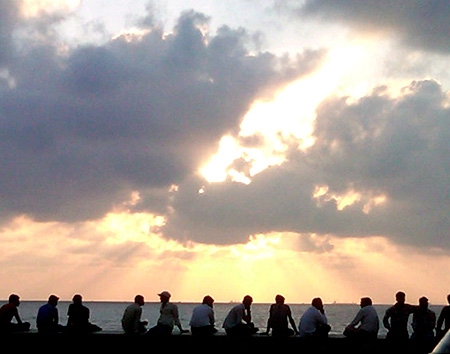It was late summer. One of those warm, balmy New York nights where you stand outside of the bar chatting for an hour instead of going home. Or you walk idly, perhaps taking the long way. Sometimes, when I was younger, on evenings like this, my girl friends and I would plop ourselves down on the sidewalk wherever we pleased, weary from our high heels, to scarf down a late-night snack from a street vendor.
On this occasion, I was with a boy. We had gone out for drinks and then spontaneously agreed on burgers at a corner diner. We strolled up Eighth Avenue, talking and flirting, and he took my hand in his. Nobody looked at us. Or gawked. Or even glanced our way. We hung out on his rooftop for a bit, and then when I left about an hour later, he gave me a long kiss goodbye on the street. His doorman didn’t stare me down with suspicion. Or contempt. I was shocked.
I was shocked that not a single soul who had glimpsed us in passing, in our affectionate moments and otherwise, had paid us any mind. After nearly two years of being ogled alone and threatened when accompanied, I found being ignored, being a part of the scenery, almost disorienting. And dizzyingly free.
I had returned just two weeks earlier from living in Mumbai. It was a city I adored. It stole my heart. But I left because I was sick of being watched. Restricted. Policed. Robbed of choice in where and how I was allowed to exist without worrying about that patriarchal gaze. In this way, Bombay, for all of the romance of its modernisation and glamour of its cosmopolitanism, broke my heart.
In my time there, I voiced my gripes openly about the way Mumbai is not as safe as we tout it to be in the larger mainstream discourse about the city. Sure, it’s better than Delhi, and sure it’s made huge strides, but to fail to acknowledge that the true public realm in India is not welcoming to women, that it is a hostile arena for women, in even the most progressive of India’s metropolises is settling for and accepting women’s status as second-class citizens.

Where are all the women? Photograph by Chaya Babu.
Women around me scoffed at this idea. I mentioned the limitations of accessing public space to a female acquaintance at dinner one night—a Bombay girl born and bred—and her defensive response had something to do with the mall. The mall. Some vapid quip about how she goes there and shops and has coffee with her friends at Moshe’s and feels completely safe. When I clarified that I was referring to actual public spaces such as parks and beaches, streets I frequent to run errands on foot and Marine Drive where I go jogging—not private ones that feel public to her—she found my longing to partake in this world absurd.
“Well, why would any woman want to go to these places you talk about when it’s just all low-class men there?” she blurted out.
“You’re an idiot,” I thought. But her comment hit closely on an argument articulated in the book Why Loiter?, which posits that by using class hierarchies and cultural standards of virtue and propriety to position “good” women against lecherous or otherwise seemingly undesirable men who inhabit public spaces, the practice of putting women away behind closed doors is presented as a benevolent tactic to protect these women versus an authoritative clamp down on their rights. In other words, the safety thing is bullshit and everyone is still scared that women might try to enjoy the city rather than just use it to get to work or the grocery store or do the other things that are okay. They might have fun. You know, they might exercise sexual choice and agency.
If this seems like a stretch to you, it’s not. There is a strong thread that ties together the freedom to be seen and the implications of that visibility on bodily autonomy and consenting sexual behavior. In Why Loiter?, Sameera Khan, Shilpa Phadke, and Shilpa Ranade write:
“The claim to seek pleasure in the city is a deeply political one that has the potential to seriously undermine the public-private boundaries that continue to circumscribe women’s access to and visibility in public space. The claim to pleasure in public space as a right also implicitly means challenging the boundaries between respectable and non-respectable women.”
Choosing this pleasure starts to erode the assumption that a woman’s body belongs to her parents, her community, her husband, and even, I don’t know, the watchman at her building or the bus driver. Basically anyone but her. A woman who decides for herself, who owns herself, is not respectable. And respectability politics are real.
The Why Loiter? ladies rightly call out the prevailing notion that women who are out in public, fiercely and boldly, “are seen to be the opposite of ‘private’ women, that is, ‘public women’ or ‘prostitutes’.” Yes. One hundred percent. I know because that was me. People totally thought I was a whore. This was proven the night I was taken to the Juhu police station while looking for a rickshaw after a party. The reason given by the officers: “For your own protection.” And yet my friend and I paid Rs. 14,000 to be released at 5 a.m.—a small price to pay to avoid the horrors that could have occurred there, but too high nonetheless.
The ideas of what’s permissible and what’s not are perhaps never explicitly stated—they never were to me—but the unspoken code is powerful. I heard it loud and clear, from people who have no relation to me whatsoever! But that’s the thing: as a woman, you are never entirely independent and detached; everyone has a stake in keeping your freedom (ahem, sexuality) in check. And they will never let you forget that. It was this incessant reminder that drove me away.
I easily moved past the police station incident, perhaps because I was naively unaware at the time that I had been in danger there, but it was the other stuff that took its toll. The little, daily, constant things. The stares, the hisses, the not-so-subtle sound of cell phone camera shutters as they snapped shots of me just going about my damn day. Of course, this too was easy to ignore at first—after all, what balls do you have to live in India if you can’t casually shrug off a leering man or two? But over time, it mattered. I succumbed to the weight of the endless eyes. Maybe not in my actions, but in my mind. I felt oppressed.
Again, I’m aware that all of this sounds extreme. I can just imagine the other women I know, ones who have lived their whole lives or chunks of years in cities in the West just like I have, giving example after example of how it’s just the same in Bombay. But I’m not talking about sitting in Café Zoe in your halter-top; I’m talking about being outside. Outside of your A/C car, outside of Palladium Mall, outside of the yoga studio.* To exist in this way is an act of resistance, even for the most privileged, liberal classes in Bombay. To do so at will without the risk of judgment, shame, or tangible repercussions is nearly impossible. Further, to exist anonymously is out of the question. Many accept these realities, however, as simple facts of life in a conservative, collective society. I do not.
I loved the steaming chai from stalls that line crowded alleys. I loved the salty heat on my back, my shoulder blades exposed to the sun. I loved the energy and sweat of weaving through packs of people. I loved when my sweet, handsome date offered to take me home from his Colaba flat on his bicycle, riding together through the damp July night. I smiled and then said no for the obvious reasons. But I want these things. To me, it is not living in a city if your life consists of being carted from one gated, glossy interior to another. NO. I want to be free.
In a famous 1970 interview, Nina Simone struggled to describe what freedom feels like. Finally she said, “I’ll tell you what freedom is to me: no fear. I mean really, no fear!” I’m not sure Nina was happy with the progress that has been made in the U.S. for women like her over the next four decades when she died this past year. To be unrestrained from the fear of sexual violence and familial and social ostracisation that comes with breaking the rules is an ongoing fight for women everywhere. But as an American woman, I’m not ready to look at my Indian counterparts and say, “Oh well, that’s India.”
* I’m aware that my perspective is specific to a woman of a certain class background, but the concepts in this piece are even more relevant to the middle-class woman who uses public transportation, accesses public spaces for her day-to-day needs, but is not at liberty to use it as she pleases.









Thank you for articulating what has been haunting my mind. For a person who calls Delhi her home, I have had my share of feeling shackled by wanton gazes and uninvited attention. My trips to Bombay would seem liberating because it was ‘relatively better’. It is a shame, how low we have set our standards. Now, living in the UK, I feel refreshingly free. As you quote Nina Simone, freedom is definitely the absence of fear.
Tragically, I don’t see that happening for women in India any time soon.
Though it might be difficult for you, I suggest reading this as well: http://nilanjanaroy.com/2013/01/03/warning-contains-sex-violence-and-honey-singh-2/.
So true. We Mumbai folks always talk about how it’s better than Delhi, but that’s just it. Better doesn’t mean it’s really good or safe.
OH MY. That is just disgusting.
Chaya, thank you for saying what needed to be said in such beautiful words. It couldn’t be more true. Growing up in Delhi, the experience of going out often seems entirely consumed by matters of logistics. Or choosing which clothes would draw least stares.
That’s time that could definitely be spent better.
Agree with each word. Thank you for writing this. Great job, Chaya.